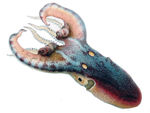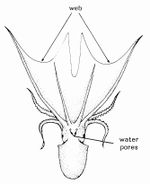Blanket octopus
| Blanket octopus |
|---|

|
| Scientific Classification |
|
| Species |
|
The Blanket Octopus, scientifically named the Tremoctopus, is common in many of the world's oceans. The Blanket Octopus can live in many places such as oceans seas and aquariums and is only known to not frequently inhabit the Arctic Ocean. The Blanket Octopus can vary in size, the male being about 5 centimeters to the female ranging up to 5 meters! The mating ritual between the male and female octopus is a truly romantic one where the male will give his life for his lady. The male octopus has an arm like structure that is full of his sperm. When the time comes, the male will attach this structure to the female and float off somewhere to die. A lot of times the female will not even notice what has happened until she notices the arm and will sprinkle it on her eggs to fertilize them. The female Blanket Octopus lives for about 12 years. The blanket octopus will defend its self by either detaching their blanket or by whacking the predator with their stolen jellyfish tentacles.
Body Design
The female Blanket Octopus is usually about two meters in length. The Octopus is made out almost completely out of tissue. Attached to the blanket octopus itself are two long leg type appendages that they use for ripping prey and using other organisms for weapons. trailing behind the blanket octopus is a webbing that looks like a blanket[1] hence the name. Despite the name, however,they use the blanket for protection mostly. When they are threatened, they will puff out their blanket making themselves appear larger than they are. However, if that doesn't work, they will literally detach their blanket from their body, thus entangling the predator and will quickly get away.[2]
The Blanket Octopus also does not shoot out ink like other octopuses, they repeat the same technique over again but also have sort of another strange way of protection. [3] skin is virtually resistant to toxin and poison of the Portuguese man of war jellyfish and will literally rip off their tentacles. After tearing the jellyfish's stinging tentacles from their bodies, the blanket octopus will then begin to swing the tentacles around like deadly stinging nunchucks stinging other organisms so that the octopus can feed on them.
Life Cycle
The mating ritual for the Blanket Octopus is a pretty strange encounter. The male Blanket Octopus is approximately 40,000 times smaller than the female while the female is about 2 meters long. [4]The male Blanket Octopus will swim up to a female and break off its arm that is full of sperm, attach it to the female, and then swim off to die. The female usually doesn't even notice but the arm will crawl into her gill slit and waits for her eggs to mature. When her eggs are ready, she will rip open the males arm and sprinkle the sperm on her eggs to fertilize them. [5]
Depending on the sex of the Blanket Octopus, they could range from being 2 to 3 meters long (female) or only 2.4 cm (male). [6] They reach sexual maturity in about 2 years and can reproduce after that. The female Blanket Octopus lives for about 5 years where as the male dies shortly after mating. This kills the male because it literally detaches his arm that is full of his sperm and attaches it to the female.[7] The blanket octopus lives in dark deep place in the ocean such as the Great Barrier Reef, the Atlantic Ocean, pacific Ocean and the Indian Ocean.[8] They lay lots of small eggs that are attached to a strong rod secreted and held by the female until hatching. This is where the octopus will stay, grow up mate and eventually die.
Ecology
The blanket Octopus is native to the very many countries such as The Untied States, France, Israel, Jamaica and many other remote places. scientists don't seem to have any research on what kind of waters that this octopus frequents in, only that they seem to be anywhere except for the frigid waters of the Arctic Ocean. The population and how many Blanket Octopus' there are is unknown but is not an endangered specie so there are quite a few of them.The blanket octopus lives in dark deep place in the ocean such as the Great Barrier Reef, and in the Atlantic Ocean, pacific Ocean and the Indian Ocean. They lay lots of small eggs that are attached to a strong rod secreted and held by the female until hatching. This is where the octopus will stay, grow up mate and eventually die.[9]
Defense
!-- To be used for some special subject not covered above. Name the Heading accordingly. For student papers, this should not be just a random collection of factoids, but some specific topic. -->]] The Blanket Octopus has a very strange habit of defense. When the opportunity arises, the Blanket Octopus will mutilate the Portuguese Man O War jellyfish, stealing their tentacles. They do this because even when the tentacle is removed from the jellyfishes body, the tentacle will still send an electric shock to the prey. So the octopus will rip off these tentacles and swing them around at their unseuspecting prey, shocking them so that these octopus' can eat them.[10]
Video
The Blanket Octopus swimming in its natural habitat.
References
- ↑ Janmeston, Joseph. RealmonstrositiesRealmonstrosities. Web. Published January 22, 2012.
- ↑ Moran, James. 5-blanket-octopus-facts 5 Blanket Octopus Facts. Web. Published April 27, 2013.
- ↑ Harmon, Kathrine. RealmonstrositiesRealmonstrosities. Web. Published April 15, 2013.
- ↑ Pickerell, John. ZME Science ZME Science. Web. Published November 18, 2016.
- ↑ Harness, Jill. ODDEE ODDEE. Web. Published February 13, 2013.
- ↑ Helm, RR. Deep Sea News Deep Sea News. Web. Published May 30, 2015.
- ↑ Pickerell, John. ZME Science ZME Science. Web. Published November 18, 2016.
- ↑ Pickerell, John. ZME ScienceZME Science. Web. Published November 18, 2016.
- ↑ Helm, Firstname. Deep Sea News Deep Sea News. Web. May 30, 2015.




